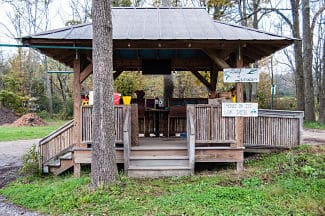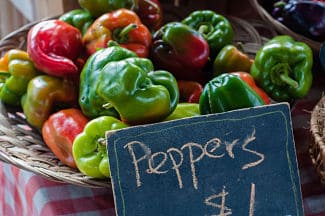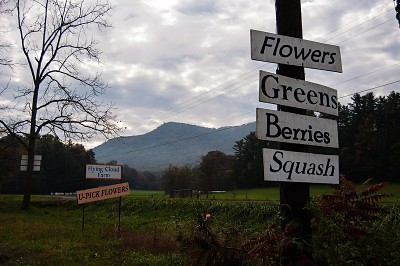10 Benefits of Organic Food
Over the past several years, much research has been done on the benefits of eating organic and local food. I want to share 10 of these benefits.
I have also highlighted these benefits in my book Farm Fresh Nutrition, so in this post, I want to share with you how you can eat more local food.

This is a self-service farm stand at Flying Cloud Farms.
Here are 10 Benefits of Organic Foods
- Buying Organic helps protect more local family farmers because large conventional farms often find organic farming non-profitable. Supporting farmers in our community has benefits beyond these 10 Benefits of Organic Foods.
- Eating organic foods means less exposure to genetically modified foods since organic foods cannot be genetically modified.
- No non-synthetic fertilizers, sewage sludge, or irradiation can be used, so pesticide residue and other chemicals that can cause harm are more likely to be minimized.
- One of the goals of growing organic food is maintaining biodiversity, which means farmers who grow organic food may grow more heirloom species and farmers who raise animals to grow heritage breeds, keeping our foods more genetically diverse.
- Because fruits, vegetables, grains, and bean seeds grown organically may be more genetically diverse, they are more likely to be more nutritious because they are not grown for their ability to be picked green, to be the same size, or to ripen artificially. In several studies, the number of antioxidants in organic food is higher than in conventional food.
- Besides being more nutritious, these heirloom varieties are tastier than conventional varieties, which are bred for conformity, not flavor.
- Pastured animals grown by organic methods are grass-fed and humanely raised without hormones or antibiotics added to food. Chickens are fed organic food. When animals are fed grass instead of grain, their meat has higher amounts of conjugated linoleic acid which may help promote health in humans.
- Organic farms help protect the environment because they don’t use pesticides that may stay in the water and soil that may pollute and take years to go away.
- Antibiotics used in animals raised for food are the biggest contributors to antibiotic resistance, making it more likely for superbugs to thrive.
- More research is needed to determine if organics help prevent disease, but it may be beneficial to eat more of them. Here is some interesting reading on the American Institute for Cancer Research.
Good Resources on Organic Food
We hear about organic food, but what does it mean? According to the USDA, here is the definition of organic.
Here is an excellent article about organic foods, according to the Mayo Clinic.
The downside to organic is the lack of availability, and the cost of food makes it so not everyone can afford these foods as easily. Large corporate farms tend to have farm subsidies instead of small farmers, which makes it an uneven playing field for what the food costs.
Ways to Advocate for Organic Food Grown Locally
- Familiarize yourself with your region’s growing seasons. What grows where and when? Here is some good information on planting schedules.
2. Purchase more food from local farmers by joining a CSA (Community Supported Agriculture) with a local farm or shop
at a local farmer’s market. Check out places to find local food in Western North Carolina and elsewhere in the resource
section on this website.
3. Ask restaurants and grocery stores to carry foods grown in your community.
4. Grow your food. Whether you have a yard or a flowerpot, there’s something special about eating food you’ve grown yourself. Here is some excellent information on how to get your garden growing!
5. Tell policymakers you value a clean, local food supply. Stay current on this issue.
Find out about advocacy groups.

Ways to Keep Your Plate Green
- Heirloom Seeds:
Foods grown organically from heirloom seeds keep our bodies and our earth healthy! Heirloom seeds have been passed down for generations and are open-pollinated. Growing a variety of heirloom seeds protects our gene pool of plants and nutrition.
You can purchase heirloom seeds from nurseries or seed stores. When you go to the farmer’s market, ask if bedding plants and produce are grown from heirloom seeds. Some grocery stores now sell some local fruits and vegetables from heirloom seeds. Do your research!
2. Follow Scientific and Government Organizations:
Several scientific organizations have voiced concerns about the chemicals used in fruit, vegetables, and animal food, and
their effect on the health of humans and wildlife. Here are just a few:
The Environmental Protection Agency
USDA Organic symbol The USDA Organic label helps consumers know which agricultural products are grown using sustainable methods, promote ecological balance, and conserve biodiversity. Synthetic fertilizers, sewage sludge, irradiation, and genetic engineering cannot be used with foods that use this label.
Find out more about the National Organic Program
Due to cost and time, local farmers may not be certified USDA organic but may still use organic growing practices. Ask the farmers in your region how they grow their food and encourage them to use organic methods. Ask farmers who grow your food what methods they use.
The Environmental Working Group created the Dirty Dozen list to help consumers know which fruits and vegetables contain the most pesticides, and these items should be purchased organically when possible. Their list of Safe 15 lets you know which foods are acceptable to buy conventionally.
Eat More Organic Food
The benefits of eating more organic food are strong enough to make me make purchases that include these. Using the Dirty Dozen and Safe 15, I have a guideline for prioritizing my purchases when I cannot wholly purchase or find organic.
I can grow foods that tend to be grown with the most pesticides or buy them from a farmer who grows them organically.
As an Asheville Nutritionist and registered dietitian, Knowing where your food comes from is a big part of being healthy. You can learn more about me and some of my Fresh Approach to Eating Programs here.
Here are some additional links on supporting local farmers and sustainable eating:
local farmers market near me (vineripenutrition.com)
Artisans Farmers Market (vineripenutrition.com)
Farm to Table Nutrition Education/Vine Ripe Nutrition
Benefits to Eating Local (vineripenutrition.com)



I am a vegetarian of almost 27 years and completely plant-based as of a few weeks ago…I feel so much better! I’ve been reading and mostly following the Engine 2 lifestyle, which has also given me sufficient inspiration to get back into the gym.
I always support my local farmers as much as I can here in Portsmouth, VA. For the first time since 1998, I have a garden I am sharing with two friends who live in Virginia Beach. I ***love*** making meals with food I’ve helped to grow! Of course, it’s all organic!
I don’t get to your corner of the state often but I’ll keep an eye on events the next time I’m in that area. smile emoticon
How exciting to have a garden this year! My cousin, Cat has told me what a wonderful farmers’ market that you have in Portsmouth. How exciting that you have made such healthy changes in your lifestyle!